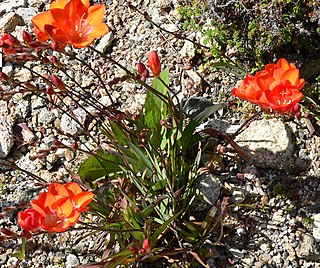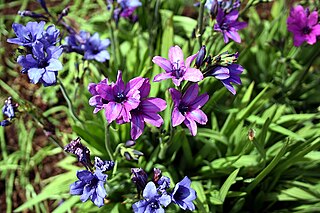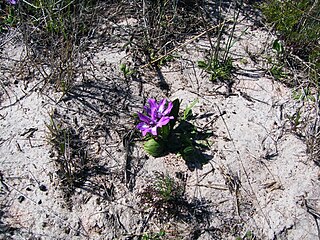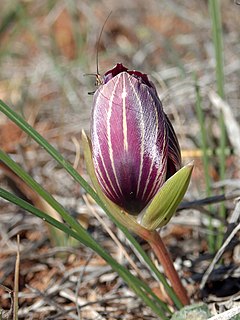
Sparaxis is a genus of flowering plants called the harlequin flowers. It belongs to the iris family Iridaceae with about 13 species endemic to Cape Province, South Africa.

Freesia is a genus of herbaceous perennial flowering plants in the family Iridaceae, first described as a genus in 1866 by Christian Friedrich Ecklon (1886) and named after the German botanist and medical practitioner, Friedrich Freese (1795-1876). It is native to the eastern side of southern Africa, from Kenya south to South Africa, most species being found in Cape Provinces. Species of the former genus Anomatheca are now included in Freesia. The plants commonly known as "freesias", with fragrant funnel-shaped flowers, are cultivated hybrids of a number of Freesia species. Some other species are also grown as ornamental plants.

Iridaceae is a family of plants in order Asparagales, taking its name from the irises, meaning rainbow, referring to its many colours. There are 66 accepted genera with a total of c. 2244 species worldwide. It includes a number of other well known cultivated plants, such as freesias, gladioli and crocuses.

Gladiolus is a genus of perennial cormous flowering plants in the iris family (Iridaceae).

Crocosmia (;), montbretia, is a small genus of flowering plants in the iris family, Iridaceae. It is native to the grasslands of southern and eastern Africa, ranging from South Africa to Sudan. One species is endemic to Madagascar.

Babiana is a genus of flowering plants in the family Iridaceae composed of about 80 recognized species. The majority of these species are endemic to the Cape Provinces of South Africa, especially Namaqualand, as well Namibia, Botswana, Zambia and Zimbabwe.

Watsonia is a genus of plants in the family Iridaceae, subfamily Crocoideae. Watsonias are native to southern Africa. The genus is named after Sir William Watson, an 18th-century British botanist.

Freesia laxa, commonly known as flowering grass, is a small species of cormous flowering plant in the family Iridaceae, from eastern and southern Africa, from Kenya to northeastern South Africa. It is grown in gardens as an ornamental plant.

Tritonia is a genus of flowering plants in the iris family first described as a genus in 1802. They are naturally distributed across southern Africa, with a high concentration of species in Cape Province of western South Africa. The genus is closely related to the genus Ixia.

Romulea is a genus of flowering plants in the family Iridaceae, first described as a genus in 1772. It is distributed in Europe, the Mediterranean, the Arabian Peninsula, and Africa.

Babiana stricta, the baboon flower or blue freesia, is a species of flowering plant in the family Iridaceae, native to Cape Province, South Africa and naturalized in Australia. Growing 10–30 cm (4–12 in) tall by 5 cm (2 in) broad, it is a cormous perennial with hairy leaves 4–12 cm (2–5 in) long. The leaves show linear venation.

Crocoideae is one of the major subfamilies in the family Iridaceae.

Watsonieae is the second largest tribe in the subfamily Crocoideae and named after the best-known genus in it — Watsonia. The members in this group are widely distributed in Africa, mainly in its southern parts.
Thereianthus is a genus of flowering plants in the family Iridaceae, first described as a genus in 1941. The entire genus is endemic to Cape Province in South Africa.

Crocosmia aurea, common names falling stars, Valentine flower, or montbretia, is a perennial flowering plant belonging to the family Iridaceae.

Babiana nana, the sandflat baboon-root, is a species of plants in the family Iridaceae. It is endemic to Cape Province of South Africa, and naturalized in Western Australia.
- Babiana nana subsp. maculata(Klatt) Goldblatt & J.C.Manning
- Babiana nana subsp. nana

Romulea sabulosa is a perennial geophyte that is assigned to the family Iridaceae. It has a few grooved thread-like leaves, and relatively large burgundy red trimerous flowers, reminiscent of crocus flowers, with yellow to light greenish with black markings and stamens with light green free filaments. It only occurs on sandy clay on renosterveld west of Nieuwoudtville in the Northern Cape province South Africa. It is called satynblom in Afrikaans.
Geissorhiza melanthera is a small perennial plant of 14–18 cm high that is assigned to the Iridaceae. It survives the dry southern summer through storage of its resources in a corm. The stem carries two or three erect, sticky leaves of up to 18 cm (7 in) long, H-shaped in cross-section. This species blooms with six to twelve bilaterally symmetrical flowers, in a spike. Sometimes the spike has one side branch with fewer flowers. Each flower has six pale beige perianth lobes, a purple-red ring around a purple red tube and three blackish stamens. Each flower is subtended by two 1¼–2¼ cm long green bracts. This species was found flowering from the end of September till mid October. It is an endemic of the western slopes of the Piketberg mountains in the Western Cape province of South Africa.

Romulea toximontana is low a herbaceous perennial geophyte in the family Iridaceae native to South Africa. It has a small corm in the soil, several linear leaves, white trimerous flowers, yolk-yellow near the centre and with a purple wash on the outside. The 1997 IUCN Red List of Threatened Plants lists this species as rare.

Romulea monadelpha is a herbaceous perennial geophyte in the family Iridaceae native to South Africa. It has a small corm in the soil, a few thread-like leaves, and trimerous dark red flowers with elaborate markings on the inside near the bottom of the flower. It is called karoo satynblom in Afrikaans.

















